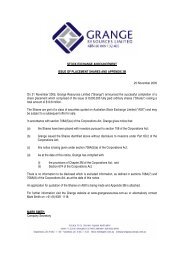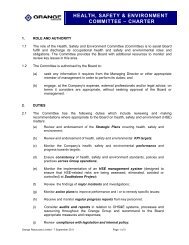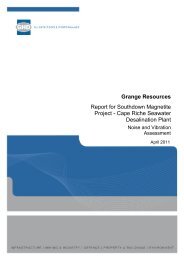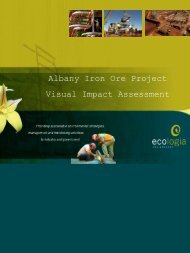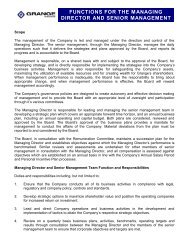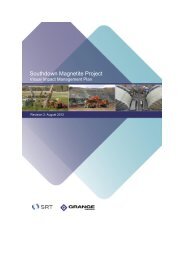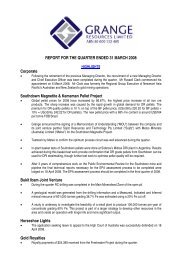2012 Annual Report (2 April 2013) - Grange Resources
2012 Annual Report (2 April 2013) - Grange Resources
2012 Annual Report (2 April 2013) - Grange Resources
You also want an ePaper? Increase the reach of your titles
YUMPU automatically turns print PDFs into web optimized ePapers that Google loves.
56<br />
PAGE<br />
<strong>2012</strong> ANNUAL REPORT<br />
Notes to the Financial Statements (cont.)<br />
NOTE 1. SUMMARY OF SIGNIFICANT<br />
ACCOUNTING POLICIES (cont.)<br />
(aa) Borrowings<br />
All borrowings are initially recognised at the fair value of the<br />
consideration received, less transaction costs. After initial<br />
recognition, borrowings are subsequently measured at amortised<br />
cost. Fees paid on the establishment of loan facilities are<br />
recognised as transaction costs of the loan to the extent that it is<br />
probable that some or all of the facility will be drawn down. In this<br />
case the fee is deferred until the draw down occurs. To the extent<br />
there is no evidence that it is probable that some or all of the<br />
facility will be drawn down, the fee is capitalised as a prepayment<br />
for liquidity services and amortised over the period of the facility to<br />
which it relates.<br />
Borrowings are removed from the balance sheet when the<br />
obligation specified in the contract is discharged, cancelled or<br />
expired. Borrowings are classified as current liabilities unless the<br />
Group has an unconditional right to defer settlement of the liability<br />
for at least 12 months after the reporting date.<br />
Borrowing costs<br />
Borrowing costs incurred for the construction of any qualifying<br />
asset are capitalised during the period of time that is required to<br />
complete and prepare the asset for its intended use or sale.<br />
Other borrowing costs are expensed.<br />
(ab) Provisions<br />
Provisions are recognised when the Group has a present<br />
obligation, it is probable that there will be a future sacrifice of<br />
economic benefits and a reliable estimate can be made of the<br />
amount of the obligation.<br />
When the Group expects some or all of a provision to be<br />
recovered from a third party, for example under an insurance<br />
contract, the receivable is recognised as a separate asset but<br />
only when the reimbursement is virtually certain and it can be<br />
measured reliably. The expense relating to any provision is<br />
presented in the income statement net of any reimbursement.<br />
If the effect of the time value of money is material, provisions are<br />
discounted using a pre-tax rate that reflects the current market<br />
assessment of the time value of money. Where this is the case,<br />
its carrying amount is the present value of these estimated<br />
future cash flows. When discounting is used, the increase in the<br />
provision due to the passage of time is recognised as a finance<br />
cost.<br />
Decommissioning and restoration<br />
Decommissioning and restoration provisions include the<br />
dismantling and demolition of infrastructure and the removal<br />
of residual materials and remediation of disturbed areas. The<br />
provision is recognised in the accounting period when the<br />
obligation arising from the related disturbance occurs, whether<br />
this occurs during the mine development or during the production<br />
phase, based on the net present value of estimated future costs.<br />
The costs are estimated on the basis of a closure plan. The cost<br />
estimates are calculated annually during the life of the operation<br />
to reflect known developments and are subject to formal review at<br />
regular intervals.<br />
The amortisation or ‘unwinding’ of the discount applied in<br />
establishing the net present value of provisions is charged to the<br />
income statement in each accounting period. The amortisation<br />
of the discount is shown as a financing cost, rather than as an<br />
operating cost. Other movements in the provisions for close<br />
down and restoration costs, including those resulting from new<br />
disturbance, updated cost estimates, changes to the lives of<br />
operations and revisions to discount rates are capitalised within<br />
mine properties and development, to the extent that any amount<br />
of deduction does not exceed the carrying amount of the asset.<br />
Any deduction in excess of the carrying amount is recognised<br />
in the income statement immediately. If an adjustment results<br />
in an addition to the cost of the related asset, consideration will<br />
be given to whether an indication of impairment exists and the<br />
impairment policy will apply. These costs are then depreciated<br />
over the life of the area of interest to which they relate.<br />
Onerous contracts<br />
An onerous contract is considered to exist where the Company<br />
has a contract under which the unavoidable cost of meeting the<br />
contractual obligations exceed the economic benefits estimated<br />
to be received. Present obligations arising under onerous<br />
contracts are recognised as a provision to the extent that the<br />
present obligation exceeds the economic benefits estimated to be<br />
received.<br />
Restructuring<br />
A provision for restructuring is recognised when the Company<br />
has developed a detailed formal plan for the restructuring and has<br />
raised a valid expectation in those affected that it will carry out the<br />
restructuring by:<br />
◆◆<br />
starting to implement the plan; or<br />
◆◆<br />
announcing its main features to those affected by it.



